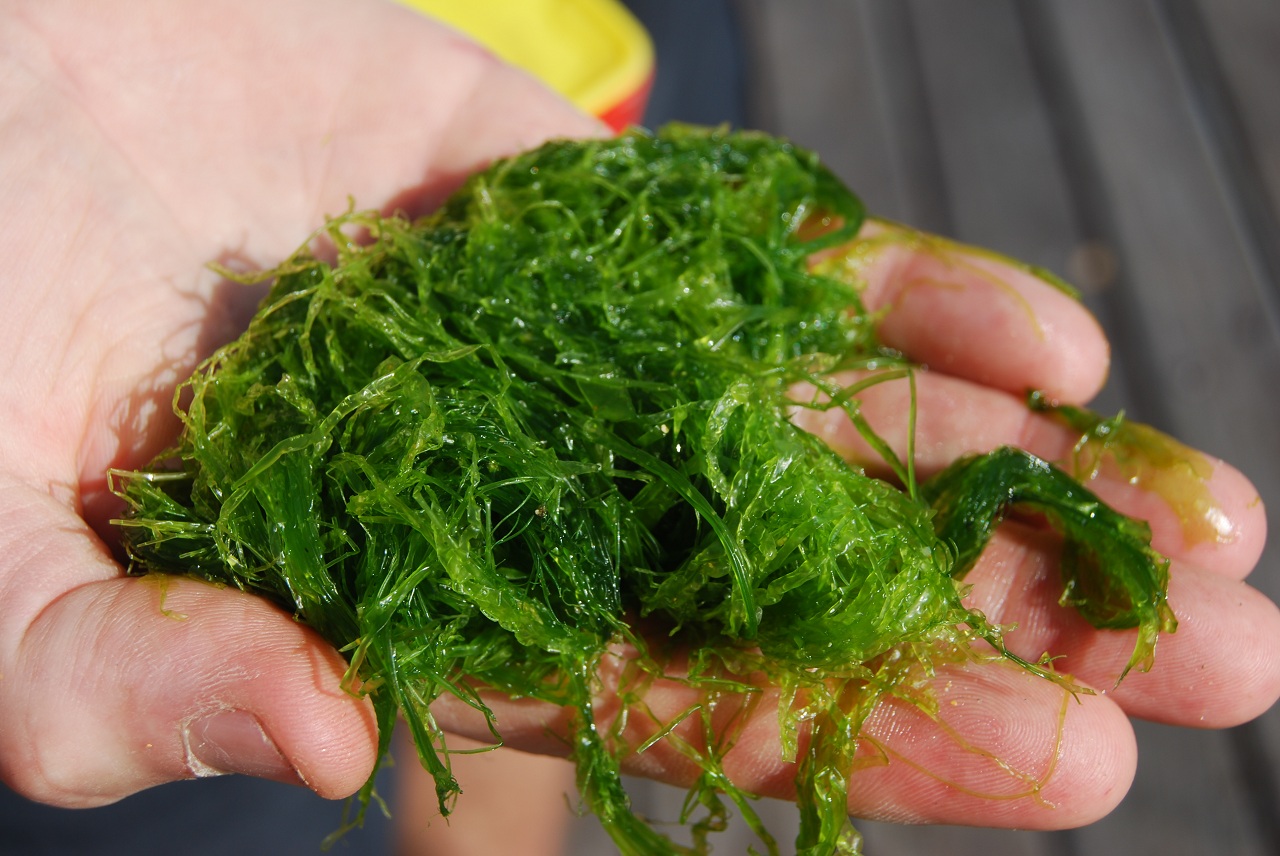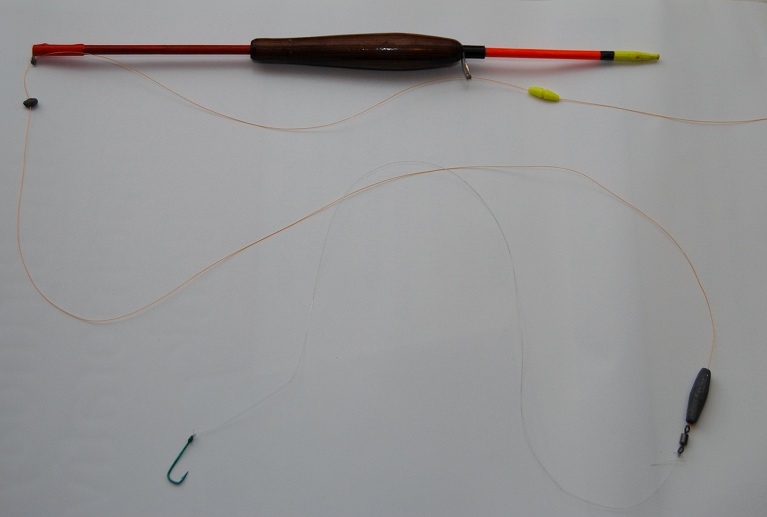Anglers in the Sydney region are very fortunate to have a great array of fish species to target. There are different target fish all year round, and although the natural tendency is for the fishing to slow down both in numbers and species as winter approaches, a change of tactics and species can bring the versatile fisherman good rewards.

Photo is of thick bubbly green algae collected from South Curl Curl rocks
Luderick, or blackfish as they are often known, are one of the most abundant slow season fish. They are fun to catch, challenging and good table fish. They are also easy to catch and the gear required simple and inexpensive. Big talk considering all of the words penned about blackfish over the years, but nevertheless, the point of this article.
If you present something that blackfish want to eat at the depth where they are feeding, they will eat it. If you can detect that they are eating it without them getting overly suspicious, then you have a chance of setting the hook. The rest of the skill is just in the delivery, getting the bait to the fish and landing the fish.
The first question is what do they want to eat, and most importantly where you can find it?
Filamentous green algae is generally known simply as weed by blackfish anglers and will usually take fish, particularly in estuaries. Cabbage or Ulva as it is properly known will also take fish, more so on the ocean rocks or close to the mouth of a river. Luckily both of these can be found on the ocean rocks, and around Sydney, this is the most reliable source of blackfish baits. Depending on time of year and weather conditions, weed can also be found in rivers and canals where the fresh meets the salt, but these supplies are notoriously unreliable. So, a trip to the ocean rocks is your best bet. Places like Mona Vale Pool, Turrimetta and South Curl Curl nearly always have enough weed and cabbage for a good blackfish outing. Store your weed and cabbage separately. The cabbage doesn’t keep well, but if you wash all of the bugs out and squeeze all of the water out, it will keep for several days wrapped in a damp cloth. Green weed keeps a little longer. Again squeeze most of the water out and wrap in a damp cloth for best results.
The second question is how to get the bait to the right depth and hold it there ?
A well weighted float is the answer. A good float allows you to set your bait to the right depth and allows the detection of bites. A quality float will sink with the slightest of effort. When a blackfish takes the bait, the float should slip effortlessly below the surface of the water. Generally the only difference between a cheap off the rack blackfish float and a good blackfish float is that the cheap off the rack float is NOT properly weighted. Take for example the cheap Force 10 floats available from BigW. They are next to useless if you use them straight out of the pack, but add some sheet lead around the base just above the bottom eyelet and wrap it with some self amalgamating tape, and you have a very serviceable float. The trick with floats is that the float should nearly sink once you have added the weight you want to the line. I use a small barrel sinker and a combination of this and the weighted float is enough to nearly sink the float. This is ideal as when a blackfish takes the bait, the float will be pulled under without the fish feeling any resistance. Re-usable split shot is an excellent tool for correctly adjusting float depth. Snowbee and Gillies sell a dispenser with different sizes of re-useable shot, these are a must have for your tackle bag.
These two points are really the most important in your blackfish quest, present what they want to eat at the right depth in such a way that when they eat it they will keep eating it. The rest of the equation is the mechanics of delivering your rig, hooking the fish and landing it, not simple skills, but simple enough for someone with some fishing experience.
Rods and reels for blackfish can be quite specialised. It is also possible to use fairly standard gear, like longer rods and an eggbeater reel. However, I would recommend that you start with inexpensive and appropriate rods and reels. A good place to start is an Alvey Blackfish reel, like a 475B, these reels retail at around $90. Look here Load the Alvey up with some quality 4kg line and you have can use it for ocean and estuary. There are a number of cheap rods to match this to if you are just starting out. A good place to start is with the Jarvis Walker Aurora Estuary blackfish, a cheap and cheerful 3m fibrelglass rod. There is also an Ocean blackfish model at 3.6 metres. Look here
Rigging is the next thing and my best tip is keep it simple. The KISS principle applies as much to blackfishing as to any other type of fishing. Running floats are the best way to go, but most of the time they can be used in a fixed position. A stopper knot can be used above the float, but these days I prefer the plastic stoppers that are sold in Korean tackle stores, they are reusable, visible and stay in one place well. A small split shot goes below the float and can be used as the lower stopper. Don’t bother with any more shot, just a barrel sinker above a small black swivel. A trace of 50 cm of lower breaking strain than the main line, 2-3 kg and a hook complete the rig. Hooks come down to angler preference, but a Mustad green sneck in size 6 is a good place to start. There is a lot of talk about the small soft mouths of blackfish, but it’s rarely the case. The fish you actually want to catch have a perfectly big enough mouth for a number 6 sneck. I actually think a lot of fish are missed in the hookup, or dropped at the net through the use of hooks that are too small.
As of 2012, Mustad green snecks are getting harder to find. I am quite happy with them, but have never favoured them for larger fish, always preferring Mustad 540 allrounders in a size 6 for fishing from the rocks for kilo plus fish. I have been stockpiling the green snecks but have also started using the number 8 Mustad 540s in the estuary to good effect. There are probably better chemically sharpened options, but the 540s are cheap, you can buy them by the box and they are effective.
The lower stopper (a small shot will do), separates the float from the lower weight. This is important when casting because it stops the rig getting tangled. This brings me to one of the hardest parts of using the rig and gear described. Casting ith a centrepin is difficult, but a skill worth learning. You can cheat and use the sidecast mode of the Alvey but I wouldn't recommend it as I describe in this article.
Once you have rigged up, test the rig in the water. In the photo above, only half of the red section plus the yellow section should be visible above the water. If not, then add a small split shot just below the float until the float is sitting correctly.
You will see a lot of two hook blackfish rigs in articles and howtos. In most situations, this is overkill, and for the beginner completely counterproductive. But, once you know what you are doing, a two hook rig can be very valuable in deep water situations. THe ability to cover more of the water column allows you to adjust depth more accurately when you are fishing over 1 rod length deep.
So that's about it for rigging. Look out for the 101 article on where to fish and what to look for in a good luderick spot.

